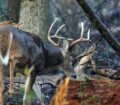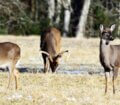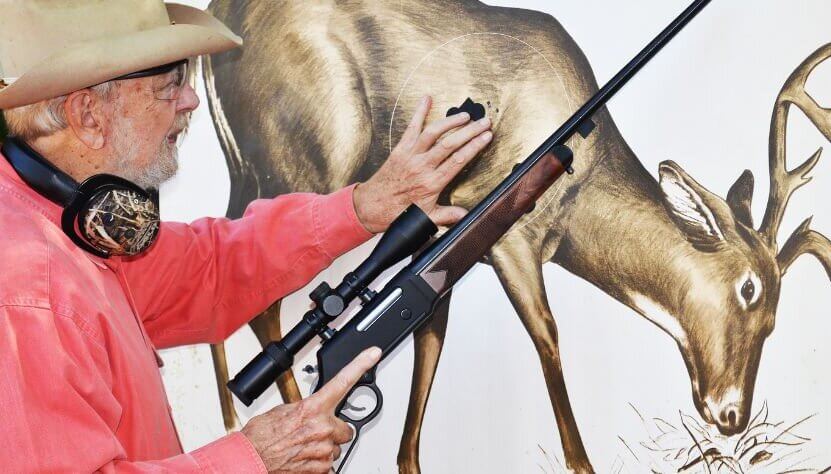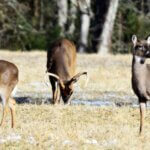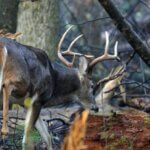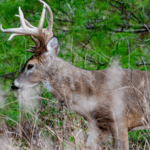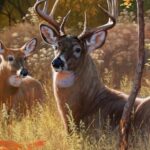Editor’s Note: Patterning is a term used frequently in the out-of-doors. Fishermen talk about patterning bass, duck hunters speak of patterning waterfowl, and deer hunters discuss patterning deer. What few of us fail to realize is that deer pattern people to survive. The older the buck, the quicker he learns to pattern hunters. The greater the hunting pressure, the easier the people and the deer are to pattern. Young bucks often die quickly. Older bucks that rely on their instincts from years past know when, where and how to retreat for cover when a human enters the woods. If you understand the mature buck deer, then you can think like him. Each buck in every situation is different, but let’s look at some examples of how to hunt these monarchs of the woods.
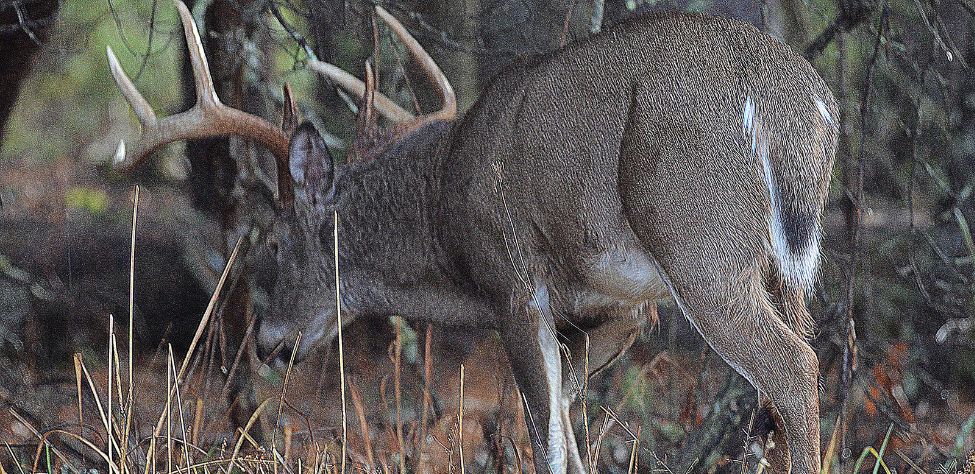
Why Hunt with a Bow During Gun/Deer Season
Often if you’ll hunt with a bow during gun/deer season, you can increase your odds of bagging a buck. When gun season occurs at the same time as bow season, gun hunters create a great deal of noise, leave a lot of scent in the woods and usually spend more time walking than they do hunting. Since these actions break-up the deer’s normal feeding and bedding patterns, oftentimes the whitetail will be very-difficult to find during gun/deer season. Many of the young bucks die quickly, while the old bucks become invisible.
- Think Like a Trophy Deer: If you’re hunting with a bow, the gun hunter very well may put that trophy in your lap – if you think like the trophy deer. To survive, that buck must hole-up in thick cover during daylight hours when hunting pressure is extremely high and not move very much. The trophy whitetail generally will be the safest in the most-dense cover he can discover. Wise bucks realize most hunters will not penetrate thick cover to find them.
- Realize Gun Hunters Shoot Further Distances: A bowman also must learn to think like the average gun hunter, who will hunt in areas that will allow him to take a shot at the maximum range of his weapon. Many shotgun deer hunters use the 3-inch magnum, which may have an effective range of 40 to 50 yards. The rifle hunter tends to choose the larger calibers and high-powered scopes to stretch his effective range out to 200 or 300 yards. If you’re hunting with a weapon that will take a deer at 200 or 300 yards, then there’s no reason to hunt the regions where your visibility is only from 15 to 30 yards. The gun hunter generally prefers to hunt open woods where his visibility matches the effective range of his weapon.
- Eliminate the Woods Further Than 40 Yards Away to Bowhunt Deer: To set-up an effective hunt plan with your bow, eliminate parts of the woods where you can see at distances greater than 40 yards, because that’s where the gun hunter will be, and where the trophy buck expects to encounter hunters. On an aerial photograph, cross out the parts of the woods where you have visibility of 50 yards or more, or do that on your app. Then begin to concentrate your hunting time in the areas where visibility will be 30 yards or less.
- Consider Hunting Very-Dense Places: Some of the most-productive bowhunting spots where you’re most likely to see a buck may have zero visibility, which will weed out all the hunters except the sportsmen who determine how to hunt these regions.
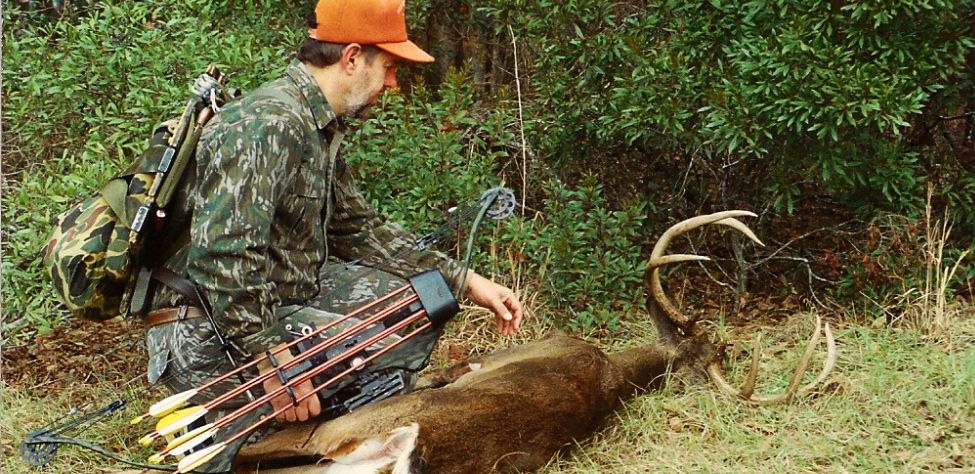
Dr. Bob Sheppard of Tuscaloosa, Alabama, an avid deer hunter, has solved this problem.
“Many times, I’ll penetrate thick cover and use a pair of pruning shears to cut shooting lanes in the foliage,” Sheppard explains. “I don’t cut a path into the thick cover. I may get down on my hands and knees and crawl. But once I arrive in these thick places like a briar thicket or a clear-cut, I’ll cut three shooting lanes in spoke fashion from my stand. The shooting lanes, which only may be 3- to 4-feet wide, may not go but for 30 yards. However, if a deer is moving through that cover, I often can get a shot at him from a shooting lane.”
Because the gunman will be hunting the open areas, he’ll force the deer into very-small pockets that often are well within bow range. Reaching these protected pockets and deciding how and where to set-up a stand to take a shot can be difficult.
- Identify Natural Breaks in Thick Cover: My friend, Don Taylor of Birmingham, Ala., a veteran trophy buck hunter of more than five decades, explains that, “Even the thickest cover has some kind of natural break in the foliage – a drainage ditch, a small creek or an open spot. But many hunters aren’t willing to go through the agony of penetrating that dense cover to attempt to locate small clearings where they can take their shots. However, these places are where the big bucks will stay when hunting pressure is high.”
- Stay Alert, and Concentrate: When you’re hunting trophy deer with a bow, consider the gun hunter an asset. If you have the ability to think like a deer, the gun hunter will force the buck to be in specific areas usually with little visibility. To be successful at bagging one of the bigger, smarter bucks, you must concentrate and stay alert for a longer time, which includes no sleeping in the tree stand or letting your mind wander. In dense-cover hunting, you only may have a few seconds to draw and shoot before the buck vanishes when the shot does present itself.
“For this reason, when I’m hunting thick cover, I don’t sit on my tree stand,” Dr. Sheppard says. “I stand up for the 1-1/2-hours I’m trying to arrow a deer. I believe I can concentrate more on my hunting, see more deer, take more shots and be more successful by staying on my feet than if I’m sitting down and casual hunting.”

How to Hunt and Take Big Buck Deer on Small Properties
In this book, you’ll hear from 14 hunters who either have gained permission or leased properties as small as six acres to as much as 250 acres, and how they consistently take older-age-class bucks off these little lands.
VERSIONS: AUDIBLE, KINDLE & PRINT

Jim Crumley’s Secrets of Bowhunting Deer
Using a black magic marker and a gray work jumpsuit, Jim Crumley of Buchanan, Virginia, drastically changed the nature and purpose of hunting camouflage when he created the first sportsman’s camouflage – Trebark. Crumley’s love of bowhunting and his desire to be more invisible changed hunting clothing forever.
In this hunting guide, he shares the wisdom that he’s learned throughout his lifetime about how to be a hunter, how to find a deer lease, how to scout for deer, and more.
Special features include how to:
- Have a magic 60 acres to hunt
- Decide the best equipment to use
- Find deer year-round
- Locate land to hunt
- Know the best place to put your tree stand
- Get bucks within bow range
VERSIONS: AUDIBLE, KINDLE & PRINT

How to Hunt Deer Like a Pro
How do you know if the land you hunt has a trophy deer on it? Wildlife manager Bob Zaiglin, of Uvalde, Texas and Jim Crumley, the father of modern-day hunting camouflage, tells you how to find out. GPS can make finding and taking that trophy buck easier. This hunting guide will teach you how to hunt big bucks where no one else can find them, how to call deer, and how to become versatile as a deer hunter, so that if one deer tactic doesn’t work, another one will.
In the chapter, “How to find Bucks at Scrape,” Dr. Keith Causey, retired professor of Wildlife Science at Auburn University, describes the best way to hunt a scrape.
Brad Harrison of Neosho, Missouri, is a nationally-known videographer, professional deer hunter and master at calling deer. Another master is Will Primos of Primos Game Calls. These two experts will tell the best deer calls and when to use them in this book.
And for over 20 years, Bo Pitman, lodge manager of White Oak Plantation, has been studying deer movement patterns. He explains what types of conditions are best for predicting deer movement.
VERSIONS: AUDIBLE, KINDLE & PRINT

Deer hunting and deer hunters are drastically changing each year. To learn new techniques for hunting deer and have more places to hunt, I’ve interviewed some of the best deer hunters in the nation and share their tactics in How to Hunt Deer Like a Pro: Volume II.
In Chapter 10, Jacob Lamar tells you his tactics for consistently taking older-age-class bucks on public lands in several states. Chapter 11, Bob Walker explains how to find places on public lands where you can hunt that 99 percent of the other hunters never have considered hunting. The Bonus Chapter with David Ramey tells you how, where, when and with what equipment to take big Kansas bucks on public lands by hunting in 100-degree weather when others won’t hunt.
Chapter 13, Mark Drury, his family and his guests take mature bucks every season by having more small places to hunt rather than one large property. Drury explains the strategy of having satellite farms to hunt that only may be 50-150 acres each or less. Chapter 15, Pat Reeve, who hunts far-northern states and Canada, says, “I don’t like hunting for mature bucks until the weather is 20 degrees or less.” Chapter 4, Dr. Larry Marchinton says that funnels are the most-reliable stand sites to hunt for big bucks and tells why.
VERSIONS: AUDIBLE & PRINT

